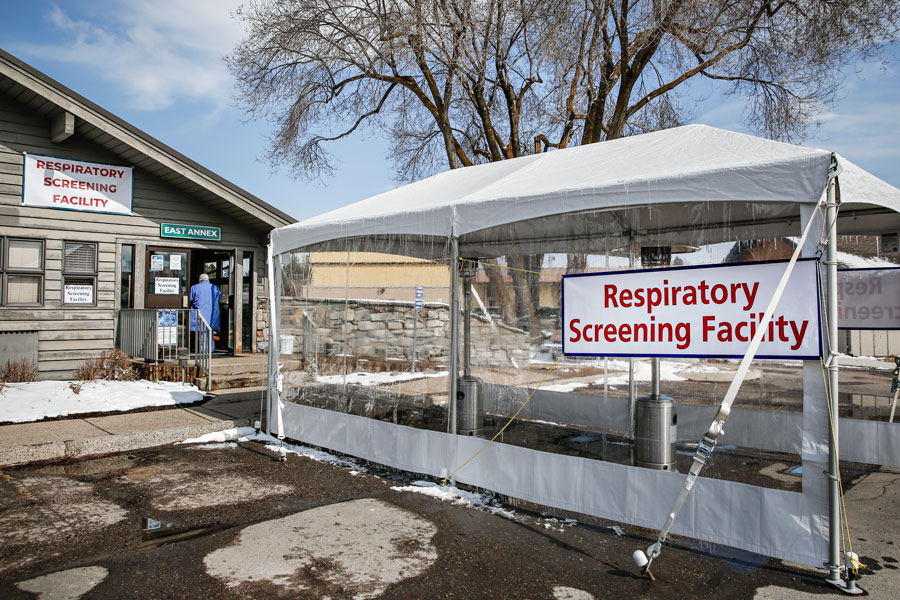Gov. Steve Bullock said last week that many cases in a recent wave of new confirmed COVID-19 infections were the result of increased testing as the state continues expanding testing capacity both broadly and in targeted areas.
Bullock said testing is beginning to ramp up in tourism communities, including developing plans in Flathead County. There has also been “large-scale community testing” occurring on American Indian reservations, as well as increased testing at nursing homes, assisted-living facilities and Department of Corrections facilities.
The expanded efforts include drive-through testing sites and testing on both symptomatic and asymptomatic people in some areas.
Over nine days from May 27 to June 3, Big Horn County in southeastern Montana reported 28 new infections, with 19 coming in a three-day period between May 27 and May 29. Bullock also announced the county’s first death, and the state’s 18th, on June 5, followed by a handful of new cases in the county in the ensuing days.
In that same nine-day stretch, Yellowstone County reported 16 new infections, including eight on May 30. Gallatin County reported over that period 14 new infections, including eight on June 3. Gallatin and Yellowstone have both had additional cases since then as well.
The only other two counties to report cases from May 27 to June 3 were Ravalli and Missoula, with one each. That nine-day stretch had come on the heels of five straight days without a new reported infection and a prolonged period of very few cases, with the exception of an outbreak in Ravalli County tied to an exclusive golf and country club.
Big Horn, Gallatin and Yellowstone County, as well as Missoula and Ravalli, are among the 20 counties identified as destination communities, which Bullock said in a May 28 announcement would receive additional resources for expanded testing. Flathead County is also on that list.
In a press conference on June 4, Bullock pointed to the correlation between the spike in new infections and increased efforts in both testing and contact tracing in the affected counties.
“It’s important to note that we’re finding many of these cases as a result of expanded testing,” Bullock said.
Bullock said at the time that investigations were ongoing, but it appeared “many of the recent cases are associated with one another,” while a handful of cases apparently involved no connections.
The governor noted that earlier in the pandemic, when testing capabilities were more limited, a positive case would prompt a contact tracing effort to identify anybody with whom the infected person had contact, but those contacted people weren’t tested unless they showed symptoms.
But now that testing capacity has increased, health officials are working to test everybody who had contact with an infected person regardless of whether they’re symptomatic, leading to the discovery of a greater number of infections while improving the chances that early identification will prevent outbreaks.
“We’re not living in that scarcity (of testing) like we were,” Bullock said. “Trying to encourage the greater testing is one of the ways we can be open and stay open and identify cases early.”
Bullock also noted the increased potential for infections now that the state is opening up, and while touting the state’s ramped-up testing efforts to better and earlier identify cases, he emphasized the importance of continued safety and hygiene precautions.
“We’ve got to understand this virus is still with us and is going to be with us for a long time,” he said. “We still have to take this seriously. Just because it’s warm and summer and we all have cabin fever, we still have to take the public-health side of this seriously, yet also recognize that with additional testing we will be identifying cases.”
Flathead City-County Public Health Officer Hillary Hanson, who is also the county’s COVID-19 incident response commander, gave a local testing update to the Kalispell City Council on June 1.
Hanson said the health center has received grant funding for “snapshot surveillance testing” this summer and expects testing for asymptomatic frontline workers to begin soon in local communities, including Whitefish, West Glacier, Bigfork, Columbia Falls and Kalispell.
“It’s really meant to hit those folks who are frontline staff, whether you’re health care, whether you’re working at a business with a large exposure to folks, a grocery store, etcetera,” Hanson said, adding: “If you have a business where you’re seeing the general public, it will be open to your employees to do it.”
While the snapshot surveillance testing won’t be ongoing, Hanson said it will offer a clearer picture of the virus in the area.
“We think it will give us a real understanding of how many cases we’re seeing in the county,” she said.
Hanson also said increased testing availability means that people from the general public who think they’re symptomatic have greater access to testing.
“We now have plenty of tests for anybody who has signs or symptoms, so if you even have one sign or symptom, go get a test,” she said.
